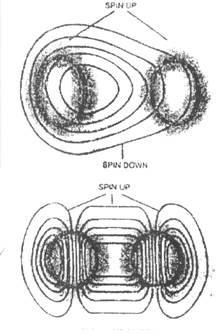Spintronics
Published on Dec 06, 2015
Abstract
Spintronics can be fairly new term for you but the concept isn't so very exotic .This technological discipline aim to exploit subtle and mind bending esoteric quantum property of electron to develop a new generation of electronics devices.
The ability to exploit spin in semiconductor promise a new logical devices as spin transistor etc with enhanced functionality higher speed and reduction power conception and might have a spark revolution in semiconductor industry. so far the problem of injecting electron with controlled spin direction has held up the realization of such spintronics
Spintronics is an emergent technology that exploits the quantum propensity of the electrons to spin as well as making use of their charge state. The spin itself is manifested as a detectable weak magnetic energy state characterised as "spin up" or "spin down".
Conventional electronic devices rely on the transport of electrical charge carriers - electrons - in a semiconductor such as silicon. Device engineers and physicists are now trying to exploit the spin of the electron rather than its charge.
Spintronic-devices combine the advantages of magnetic materials and semiconductors. They are expected to be non-volatile, versatile, fast and capable of simultaneous data storage and processing, while at the same time consuming less energy. Spintronic-devices are playing an increasingly significant role in high-density data storage, microelectronics, sensors, quantum computing and bio-medical applications, etc.
Semiconductor spintronics devices combine advantages of semiconductor with the concept of magnetoelectronics. This category of devices includes spin diodes, spin filter, and spin FET. To make semiconductor based spintronic devices, researchers need to address several following different problems. A first problem is creation of inhomogeneous spin distribution. It is called spin-polarisation or spin injection. Spin-polarised current is the primary requirement to make semiconductor spintronics based devices. It is also very fragile state. Therefore, the second problem is achieving transport of spin-polarised electrons maintaining their spin-orientation.
Final problem, related to application, is relaxation time. This problem is even more important for the last category devices. Spin comes to equilibrium by the phenomenon called spin relaxation. It is important to create long relaxation time for effective spin manipulation, which will allow additional spin degree of freedom to spintronics devices with the electron charge. Utilizing spin degree of freedom alone or add it to mainstream electronics will significantly improve the performance with higher capabilities.
The third category devices are being considered for building quantum computers. Quantum information processing and quantum computation is the most ambitious goal of spintronics research. The spins of electrons and nuclei are the perfect candidates for quantum bits or qubits. Therefore, electron spin and nuclear based hardwares are some of the main candidates being considered for quantum computers.
Spintronics based devices offers several advantages over conventional charge based devices. Since magnetised materials maintain their spin even without power, spintronics based devices could be the basis of non-volatile memory device. Energy efficiency is another virtue of these devices as spin can be manipulated by low-power external magnetic field. Miniaturisation is also another advantage because spintronics can be coupled with conventional semiconductor and optoelectronic devices.
However, temperature is still a major bottleneck. Practical application of spintronics needs room-temperature ferromagnet in semiconductors. Making such materials represents a substantial challenge for materials scientists.

From this simple device it’s hoped to make incredibly tiny chips that will act as super-fast memories whose contents will survive loss of power. The adjective is spintronic. The ability to exploit spin in semiconductors promises new logic devices. With enhanced fimctiona1ity higher speed, and reduced power consumption, and might spark a revolution in the semiconductor industry. So far the problem of injecting electrons with a controlled spin direction has held up the realization of such spintronic devices
ELECTRONICS VS SPINTRONICS
One of the most inherent advantages of spintronics over electronics is that magnets tend to stay magnetised, which is sparking in the industry an interest for replacing computers’ semiconductor-based components with magnetic ones, starting with the random access memory (RAM), Let me tell you an example: You are in the mid of documenting a project presentation that you need to present tomorrow morning and you face an electric power failure. Your UPS was not recharged and, the worst part of all, you didn’t save your presentation. I am sure that a condition like this is enough, to leave you back, pulling your hair, for now you have to do the same task right from the scratch.
You need to do all this just because all the information that is stored via electron charges is lost as soon as you face the power failure. And that is why before turning a computer off, you are bound to save your new work to a disk.
Imagine a computer that retains all the information put into it: it’s really possible with all-magnetic RAM. Most importantly, there would be no ‘boot-up’ waiting period when the power is first turned on a great advantage, especially for laptop users.
Another promising feature of spintronics is that it does not require the use of unique and specialised semiconductors, thereby allowing it to work with common metals like copper, alumimum, and silver. So the cost of such devices for you is unlikely to be high even in the beginning.